A Comparative Study of the Simulation Accuracy and Efficiency for the Urban Wind Environment Based on CFD Plug-Ins Integrated into Architectural Design Platforms
Abstract
:1. Introduction
2. Methodology
2.1. Study Object
2.2. CFD Simulation Tools Integrated into Architectural Design Platforms
2.2.1. Autodesk CFD
2.2.2. Butterfly
2.2.3. GH_Wind
2.3. Computational Domain and Boundary Conditions
2.4. Grid Generation and Mesh Independence Tests
2.4.1. Butterfly
2.4.2. Autodesk CFD
2.4.3. GH_Wind
2.5. Numerical Method and Turbulence Models
3. Results and Discussion
3.1. Analysis of Simulation Accuracy
3.1.1. 0° Wind Direction
3.1.2. 22.5° Wind Direction
3.1.3. 45° Wind Direction
3.1.4. Summary
3.2. Analysis of Computational Time Cost
3.3. Characteristics and Applicability of Different Plug-Ins
3.3.1. Advantages and Disadvantages
3.3.2. Application Suggestions
4. Conclusions
- While the CFD plug-in simplifies the CFD method and workflow, it still requires the users to have some basic CFD knowledge. Several CFD plug-ins have developed clear GUIs and automatic meshing functions to help users quickly get started with CFD simulations. The FFD method was integrated into the architectural design platform to support the rapid airflow simulations.
- The structured hexahedral meshes generated by Butterfly are relatively easy to achieve mesh independence. The unstructured tetrahedral meshes automatically generated by Autodesk CFD can achieve mesh independence with a small number of the total meshes. However, the uniformly distributed voxelized meshes generated by GH_Wind do not support local encryption, making it a challenge to achieve grid independence.
- All CFD plug-ins underestimate the wind velocity at the pedestrian level inside the urban block in any wind direction. Butterfly had the best simulation accuracy under 0° wind direction. Autodesk CFD has the best simulation accuracy at 22.5° and 45° wind direction. With the increase in the incoming wind angle, the simulation accuracy of Autodesk CFD tends to improve, while the simulation accuracy of GH_Wind decreases continuously.
- The CFD plug-in generally has a low simulation accuracy for the leeward area of the obstacles at the pedestrian level, especially GH_Wind. Butterfly had good prediction accuracy in the strong wind regions, while its prediction ability was weak in the entrance and exit areas of the streets, but this problem improved with the increase in the inflow angle. Autodesk CFD maintains good prediction accuracy in low wind speed regions.
- Autodesk CFD achieves a good balance between simulation accuracy and speed. However, GH_Wind using the FFD method does not support a local adjustment of the grid size, which leads to a large number of generated grids and a sharp increase in computational time.
- Of the three plug-ins, Butterfly is the most difficult for urban planners and architects to learn and operate, while Autodesk CFD and GH_Wind are architect-friendly. The combination of the FFD method and the ML algorithm on an architectural design platform can effectively improve the simulation accuracy of GH_Wind.
Author Contributions
Funding
Data Availability Statement
Conflicts of Interest
Nomenclature
| ABL | Atmospheric boundary layer |
| AIJ | Architectural Institute of Japan |
| CFD | Computational fluid dynamics |
| COST | The European cooperation in the field of scientific and technical research |
| FFD | Fast fluid dynamics |
| GIS | The geographic information systems |
| GUI | Graphical user interface |
| LTCM | Large time step and coarse mesh |
| ML | Machine learning |
| RNGKE | The re-normalization group k-epsilon turbulence model |
| SHM | Snappy hex mesh method |
| SSTKW | The SST k-omega turbulence model |
| STKE | The standard k-epsilon turbulence model |
| WRF | The weather research and forecasting models |
| The local building topography | |
| The index of the nearby weather station with a value of 0.1 | |
| The von Karman constant (-) | |
| Reynold number (-) | |
| The friction velocity of the atmospheric boundary layer (m/s) | |
| (m/s) | |
| The roughness height of surface (m) | |
| The reference height (m) | |
| Numerical viscosity (-) | |
| The reference boundary layer thickness (m) | |
| The indices of boundary layer thickness (m) |
References
- National Bureau of Statistics. The Seventh National Census. Natl. Bur. Stat. 2021. Available online: http://www.gov.cn/shuju/hgjjyxqk/detail.html?q=3 (accessed on 16 September 2022).
- Yang, Y.; Guangrong, S.; Chen, Z.; Hao, S.; Zhouyiling, Z.; Shan, Y. Quantitative analysis and prediction of urban heat island intensity on urban-rural gradient: A case study of Shanghai. Sci. Total Environ. 2022, 829, 154264. [Google Scholar] [CrossRef] [PubMed]
- Tominaga, Y.; Stathopoulos, T. CFD simulation of near-field pollutant dispersion in the urban environment: A review of current modeling techniques. Atmos. Environ. 2013, 79, 716–730. [Google Scholar] [CrossRef]
- Kastner-Klein, P.; Berkowicz, R.; Britter, R. The influence of street architecture on flow and dispersion in street canyons. Meteorol. Atmos. Phys. 2004, 87, 121–131. [Google Scholar] [CrossRef]
- Pioppi, B.; Pigliautile, I.; Piselli, C.; Pisello, A.L. Cultural heritage microclimate change: Human-centric approach to experimentally investigate intra-urban overheating and numerically assess foreseen future scenarios impact. Sci. Total Environ. 2020, 703, 134448. [Google Scholar] [CrossRef] [PubMed]
- Kaseb, Z.; Rahbar, M. Towards CFD-based optimization of urban wind conditions: Comparison of Genetic algorithm, Particle Swarm Optimization, and a hybrid algorithm. Sustain. Cities Soc. 2022, 77, 103565. [Google Scholar] [CrossRef]
- Juan, Y.-H.; Wen, C.-Y.; Li, Z.; Yang, A.-S. A combined framework of integrating optimized half-open spaces into buildings and an application to a realistic case study on urban ventilation and air pollutant dispersion. J. Build. Eng. 2021, 44, 102975. [Google Scholar] [CrossRef]
- Li, Q.; Liang, J.; Wang, Q.; Chen, Y.; Yang, H.; Ling, H.; Luo, Z.; Hang, J. Numerical investigations of urban pollutant dispersion and building intake fraction with various 3D building configurations and tree plantings. Int. J. Environ. Res. Public Health 2022, 19, 3524. [Google Scholar] [CrossRef]
- Gan, L.; Ren, H.; Cai, W.; Wu, K.; Liu, Y.; Liu, Y. Allocation of carbon emission quotas for China’s provincial public buildings based on principles of equity and efficiency. Build. Environ. 2022, 216, 108994. [Google Scholar] [CrossRef]
- Tsai, W.-T.; Tsai, C.-H. Interactive analysis of green building materials promotion with relevance to energy consumption and greenhouse gas emissions from Taiwan’s building sector. Energy Build. 2022, 261, 111959. [Google Scholar] [CrossRef]
- Li, H.; Zhao, Y.; Sützl, B.; Kubilay, A.; Carmeliet, J. Impact of green walls on ventilation and heat removal from street canyons: Coupling of thermal and aerodynamic resistance. Build. Environ. 2022, 214, 108945. [Google Scholar] [CrossRef]
- Tominaga, Y.; Stathopoulos, T. CFD modeling of pollution dispersion in a street canyon: Comparison between LES and RANS. J. Wind Eng. Ind. Aerodyn. 2011, 99, 340–348. [Google Scholar] [CrossRef]
- Blocken, B.; Stathopoulos, T.; Carmeliet, J. CFD simulation of the atmospheric boundary layer: Wall function problems. Atmos. Environ. 2007, 41, 238–252. [Google Scholar] [CrossRef]
- Blocken, B. 50 years of computational wind engineering: Past, present and future. J. Wind Eng. Ind. Aerodyn. 2014, 129, 69–102. [Google Scholar] [CrossRef]
- Wong, M.S.; Nichol, J.; Ng, E. A study of the “wall effect” caused by proliferation of high-rise buildings using GIS techniques. Landsc. Urban Plan. 2011, 102, 245–253. [Google Scholar] [CrossRef]
- Yuan, C.; Ren, C.; Ng, E. GIS-based surface roughness evaluation in the urban planning system to improve the wind environment–A study in Wuhan, China. Urban Clim. 2014, 10, 585–593. [Google Scholar] [CrossRef]
- He, X.; Li, Y.; Wang, X.; Chen, L.; Yu, B.; Zhang, Y.; Miao, S. High-resolution dataset of urban canopy parameters for Beijing and its application to the integrated WRF/Urban modelling system. J. Clean. Prod. 2019, 208, 373–383. [Google Scholar] [CrossRef]
- Shen, C.; Shen, A.; Cui, Y.; Chen, X.; Liu, Y.; Fan, Q.; Chan, P.; Tian, C.; Wang, C.; Lan, J. Spatializing the roughness length of heterogeneous urban underlying surfaces to improve the WRF simulation-part 1: A review of morphological methods and model evaluation. Atmos. Environ. 2021, 270, 118874. [Google Scholar] [CrossRef]
- Gao, C.; Hao, M.; Chen, J.; Gu, C. Simulation and design of joint distribution of rainfall and tide level in Wuchengxiyu Region, China. Urban Clim. 2021, 40, 101005. [Google Scholar] [CrossRef]
- Xu, X.; Niu, D.; Xiao, B.; Guo, X.; Zhang, L.; Wang, K. Policy analysis for grid parity of wind power generation in China. Energy Policy 2020, 138, 111225. [Google Scholar] [CrossRef]
- Zhou, W.; Liu, J.; Lei, J.; Yu, L.; Hwang, J.-N. GMNet: Graded-feature multilabel-learning network for RGB-thermal urban scene semantic segmentation. IEEE Trans. Image Process. 2021, 30, 7790–7802. [Google Scholar] [CrossRef] [PubMed]
- Zhong, J.; Liu, J.; Xu, Y.; Liang, G. Pedestrian-level gust wind flow and comfort around a building array–influencing assessment on the pocket park. Sustain. Cities Soc. 2022, 83, 103953. [Google Scholar] [CrossRef]
- Toparlar, Y.; Blocken, B.; Maiheu, B.; Van Heijst, G. A review on the CFD analysis of urban microclimate. Renew. Sustain. Energy Rev. 2017, 80, 1613–1640. [Google Scholar] [CrossRef]
- Xu, F.; Gao, Z.; Zhang, J.; Hu, Y.; Ding, W. Influence of typical street-side public building morphologies on the ventilation performance of streets and squares. Build. Environ. 2022, 221, 109331. [Google Scholar] [CrossRef]
- Kaijima, S.; Bouffanais, R.; Willcox, K.; Naidu, S. Computational fluid dynamics for architectural design. Archit. Des. 2013, 83, 118–123. [Google Scholar]
- ANSYS. Fluent. Available online: https://www.ansys.com/products/fluids/ansys-fluent (accessed on 16 September 2022).
- CHAM. PHOENICS. Available online: https://www.cham.co.uk/rhinoCFD.php (accessed on 16 September 2022).
- Jasak, H.; Jemcov, A.; Tukovic, Z. OpenFOAM: A C++ library for complex physics simulations. In International Workshop on Coupled Methods in Numerical Dynamics; IUC Dubrovnik Croatia: Dubrovnik, Croatia, 2007; pp. 1–20. [Google Scholar]
- Zheng, X.; Yang, J. Impact of moving traffic on pollutant transport in street canyons under perpendicular winds: A CFD analysis using large-eddy simulations. Sustain. Cities Soc. 2022, 82, 103911. [Google Scholar] [CrossRef]
- Zhang, Y.; Ou, C.; Chen, L.; Wu, L.; Liu, J.; Wang, X.; Lin, H.; Gao, P.; Hang, J. Numerical studies of passive and reactive pollutant dispersion in high-density urban models with various building densities and height variations. Build. Environ. 2020, 177, 106916. [Google Scholar] [CrossRef]
- Han, T.; Huang, Q.; Zhang, A.; Zhang, Q. Simulation-based decision support tools in the early design stages of a green building—A review. Sustainability 2018, 10, 3696. [Google Scholar] [CrossRef]
- Hu, Y.; Peng, Y.; Gao, Z.; Xu, F. Application of CFD plug-ins integrated into urban and building design platforms for performance simulations: A literature review. Front. Archit. Res. 2022, in press. [CrossRef]
- Mackey, C.; Sadeghipour Roudsari, M. The tool (s) versus the toolkit. In Humanizing Digital Reality; Springer: Berlin/Heidelberg, Germany, 2018; pp. 93–101. [Google Scholar]
- Zuo, W.; Chen, Q. Real-time or faster-than-real-time simulation of airflow in buildings. Indoor Air 2009, 19, 33. [Google Scholar] [CrossRef]
- Zuo, W.; Chen, Q. Fast and informative flow simulations in a building by using fast fluid dynamics model on graphics processing unit. Build. Environ. 2010, 45, 747–757. [Google Scholar] [CrossRef]
- Attia, S.; Hensen, J.L.; Beltrán, L.; De Herde, A. Selection criteria for building performance simulation tools: Contrasting architects’ and engineers’ needs. J. Build. Perform. Simul. 2012, 5, 155–169. [Google Scholar] [CrossRef] [Green Version]
- Bosselmann, P.; Arens, E.; Dunker, K.; Wright, R. Urban form and climate: Case study, Toronto. J. Am. Plan. Assoc. 1995, 61, 226–239. [Google Scholar] [CrossRef]
- Sousa, J.P.M.; Moya, R.A.C.; Prohasky, D.; Vaz, C.E.V. Empirical analysis of three wind simulation tools to support urban planning in early stages of design. In Proceedings of the 19th Conference of the Iberoamerican Society of Digital Graphics, Florianópolis, SC, Brasil, 23–27 November 2015; pp. 363–370. [Google Scholar]
- Si, B.; Tian, Z.; Jin, X.; Zhou, X.; Tang, P.; Shi, X. Performance indices and evaluation of algorithms in building energy efficient design optimization. Energy 2016, 114, 100–112. [Google Scholar] [CrossRef]
- Wortmann, T. Opossum-introducing and evaluating a model-based optimization tool for grasshopper. In Proceedings of the 22nd CAADRIA Conference, Xi’an Jiaotong-Liverpool University, Suzhou, China, 5–8 April 2017; pp. 283–292. [Google Scholar]
- Marcum, D.L.; Weatherill, N.P. Unstructured grid generation using iterative point insertion and local reconnection. AIAA J. 1995, 33, 1619–1625. [Google Scholar] [CrossRef]
- Löhner, R. Automatic unstructured grid generators. Finite Elem. Anal. Des. 1997, 25, 111–134. [Google Scholar] [CrossRef]
- Nakahashi, K.; Ito, Y.; Togashi, F. Some challenges of realistic flow simulations by unstructured grid CFD. Int. J. Numer. Methods Fluids 2003, 43, 769–783. [Google Scholar] [CrossRef]
- Waibel, C.; Bystricky, L.; Kubilay, A.; Evins, R.; Carmeliet, J. Validation of Grasshopper-based Fast Fluid Dynamics for Air Flow around Buildings in Early Design Stage. In Proceedings of the 15th International Conference of IBPSA-Building Simulation 2017, San Francisco, CA, USA, 7–9 August 2017; pp. 7–9. [Google Scholar]
- Chronis, A.; Dubor, A.; Cabay, E.; Roudsari, M.S. Integration of CFD in Computational Design-An evaluation of the current state of the art. In Proceedings of the 35th eCAADe Conference, Sapienza University of Rome, Rome, Italy, 20–22 September 2017; pp. 601–610. [Google Scholar]
- De Luca, F. Environmental performance-driven Urban Design: Parametric design method for the integration of daylight and urban comfort analysis in cold climates. In Proceedings of the International Conference on Computer-Aided Architectural Design Futures, Daejeon, Korea, 26–28 June 2019; Springer: Singapore, 2019; pp. 15–31. [Google Scholar]
- Li, J.; Delmas, A.; Donn, M.; Willis, R. Validation and comparison of different CFD simulation software predictions of urban wind environment based on AIJ wind tunnel benchmarks. In Proceedings of the Symposium on Simulation for Architecture and Urban Design, Delft, The Netherlands, 5–7 June 2018; pp. 1–7. [Google Scholar]
- Chang, C.-H.; Meroney, R.N. Concentration and flow distributions in urban street canyons: Wind tunnel and computational data. J. Wind Eng. Ind. Aerodyn. 2003, 91, 1141–1154. [Google Scholar] [CrossRef]
- Di Sabatino, S.; Buccolieri, R.; Pulvirenti, B.; Britter, R. Simulations of pollutant dispersion within idealised urban-type geometries with CFD and integral models. Atmos. Environ. 2007, 41, 8316–8329. [Google Scholar] [CrossRef]
- Zhang, M.; Gao, Z. Effect of urban form on microclimate and energy loads: Case study of generic residential district prototypes in Nanjing, China. Sustain. Cities Soc. 2021, 70, 102930. [Google Scholar] [CrossRef]
- Csavina, J.; Field, J.; Félix, O.; Corral-Avitia, A.Y.; Sáez, A.E.; Betterton, E.A. Effect of wind speed and relative humidity on atmospheric dust concentrations in semi-arid climates. Sci. Total Environ. 2014, 487, 82–90. [Google Scholar] [CrossRef] [PubMed]
- Van Hooff, T.; Blocken, B. Coupled urban wind flow and indoor natural ventilation modelling on a high-resolution grid: A case study for the Amsterdam ArenA stadium. Environ. Model. Softw. 2010, 25, 51–65. [Google Scholar] [CrossRef]
- Shen, J.; Gao, Z.; Ding, W.; Yu, Y. An investigation on the effect of street morphology to ambient air quality using six real-world cases. Atmos. Environ. 2017, 164, 85–101. [Google Scholar] [CrossRef]
- Peng, Y.; Gao, Z.; Buccolieri, R.; Shen, J.; Ding, W. Urban ventilation of typical residential streets and impact of building form variation. Sustain. Cities Soc. 2021, 67, 102735. [Google Scholar] [CrossRef]
- Zhang, M.; You, W.; Qin, Q.; Peng, D.; Hu, Y.; Gao, Z.; Buccolieri, R. Investigation of typical residential block typologies and their impact on pedestrian-level microclimate in summers in Nanjing, China. Front. Archit. Res. 2022, 11, 278–296. [Google Scholar] [CrossRef]
- Xu, F.; Gao, Z.; Xing, Y.; Wu, Z.; Zhang, J.; Liao, Y.; Hu, Y. The Effect of Village Morphological Variation Caused by Economic Development on Residents’ Health and Rural Ventilation in Tianjin. Buildings 2022, 12, 1393. [Google Scholar] [CrossRef]
- Xie, P.; Yang, J.; Sun, W.; Xiao, X.; Xia, J.C. Urban scale ventilation analysis based on neighborhood normalized current model. Sustain. Cities Soc. 2022, 80, 103746. [Google Scholar] [CrossRef]
- Fang, Y.; Zhao, L. Assessing the environmental benefits of urban ventilation corridors: A case study in Hefei, China. Build. Environ. 2022, 212, 108810. [Google Scholar] [CrossRef]
- Tominaga, Y.; Mochida, A.; Yoshie, R.; Kataoka, H.; Nozu, T.; Yoshikawa, M.; Shirasawa, T. AIJ guidelines for practical applications of CFD to pedestrian wind environment around buildings. J. Wind Eng. Ind. Aerodyn. 2008, 96, 1749–1761. [Google Scholar] [CrossRef]
- Xu, F.; Yang, J.; Zhu, X. A comparative study on the difference of CFD simulations based on a simplified geometry and a more refined BIM based geometry. AIP Adv. 2020, 10, 125318. [Google Scholar] [CrossRef]
- Johansson, E.; Yahia, M.W. Wind comfort and solar access in a coastal development in Malmö, Sweden. Urban Clim. 2020, 33, 100645. [Google Scholar] [CrossRef]
- Mochida, A.; Tominaga, Y.; Murakami, S.; Yoshie, R.; Ishihara, T.; Ooka, R. Comparison of various k-ε models and DSM applied to flow around a high-rise building-report on AIJ cooperative project for CFD prediction of wind environment. Wind Struct. 2002, 5, 227–244. [Google Scholar] [CrossRef] [Green Version]
- Autodesk. Autodesk CFD. Available online: https://www.autodesk.com.cn/products/cfd/overview (accessed on 16 September 2022).
- Roudsari, M.S.; Mackey, C. Butterfly. Ladybug Tools Butterfly. Available online: https://www.ladybug.tools/butterfly.html (accessed on 16 September 2022).
- Stam, J. Stable Fluids. In Proceedings of the 26th Annual Conference on Computer Graphics and Interactive Techniques, SIGGRAPH 99, Los Angeles, CA USA, 8–13 August 1999; pp. 121–128. [Google Scholar]
- Mortezazadeh, M.; Wang, L.L. Solving city and building microclimates by fast fluid dynamics with large timesteps and coarse meshes. Build. Environ. 2020, 179, 106955. [Google Scholar] [CrossRef]
- Blocken, B.; Stathopoulos, T.; Van Beeck, J. Pedestrian-level wind conditions around buildings: Review of wind-tunnel and CFD techniques and their accuracy for wind comfort assessment. Build. Environ. 2016, 100, 50–81. [Google Scholar] [CrossRef]
- Franke, J. Recommendations of the COST action C14 on the use of CFD in predicting pedestrian wind environment. In Proceedings of the The Fourth International Symposium on Computational Wind Engineering, Yokohama, Japan, 16–19 July 2006; pp. 529–532. [Google Scholar]
- You, W.; Ding, W. Effects of urban square entry layouts on spatial ventilation under different surrounding building conditions. Build. Simul. 2021, 14, 377–390. [Google Scholar] [CrossRef]
- Blocken, B.; Carmeliet, J. Pedestrian wind environment around buildings: Literature review and practical examples. J. Therm. Envel. Build. Sci. 2004, 28, 107–159. [Google Scholar] [CrossRef]
- Zuo, W.; Jin, M.; Chen, Q. Reduction of numerical diffusion in FFD model. Eng. Appl. Comput. Fluid Mech. 2012, 6, 234–247. [Google Scholar] [CrossRef]
- Sun, H.; Burton, H.V.; Huang, H. Machine learning applications for building structural design and performance assessment: State-of-the-art review. J. Build. Eng. 2021, 33, 101816. [Google Scholar] [CrossRef]
- Østergård, T.; Jensen, R.L.; Maagaard, S.E. Building simulations supporting decision making in early design—A review. Renew. Sustain. Energy Rev. 2016, 61, 187–201. [Google Scholar] [CrossRef]
- Natanian, J.; Kastner, P.; Dogan, T.; Auer, T. From energy performative to livable Mediterranean cities: An annual outdoor thermal comfort and energy balance cross-climatic typological study. Energy Build. 2020, 224, 110283. [Google Scholar] [CrossRef]
- Waibel, C.; Zhang, R.; Wortmann, T. Physics Meets Machine Learning: Coupling FFD with Regression Models for Wind Pressure Prediction on High-Rise Facades; Association for Computing Machinery: New York, NY, USA, 2021; Volume 1. [Google Scholar]
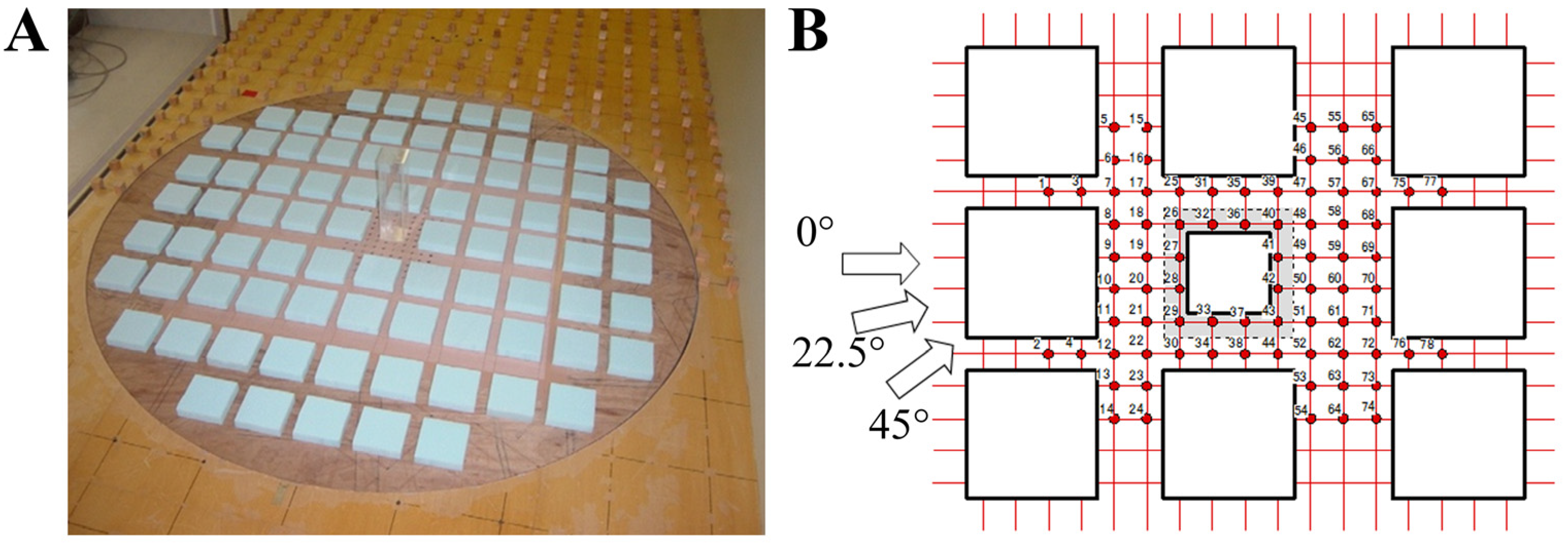


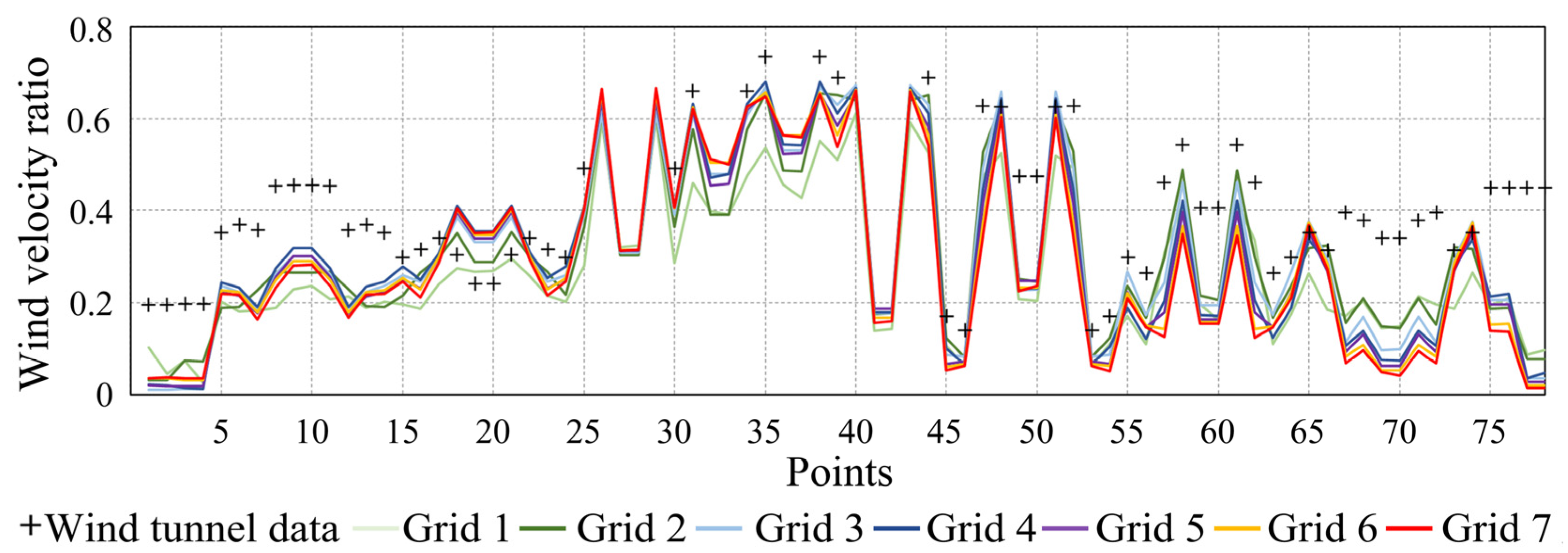

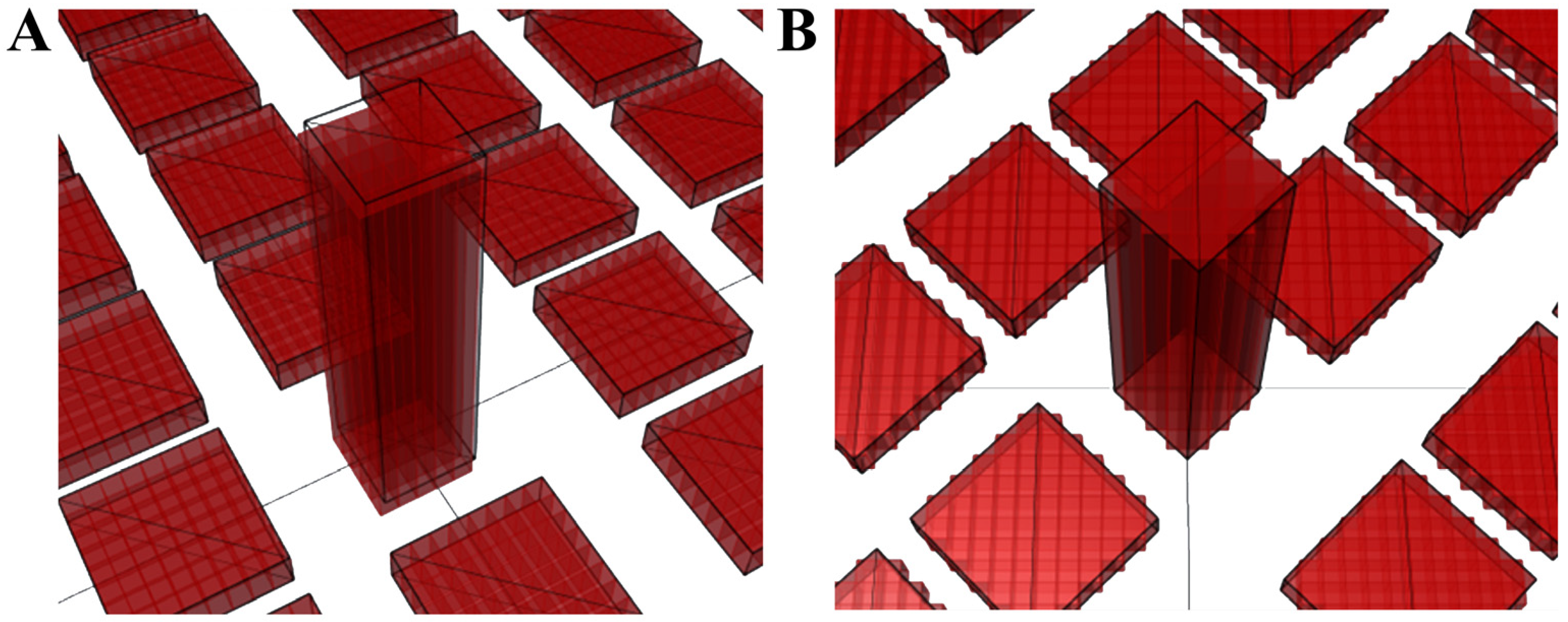


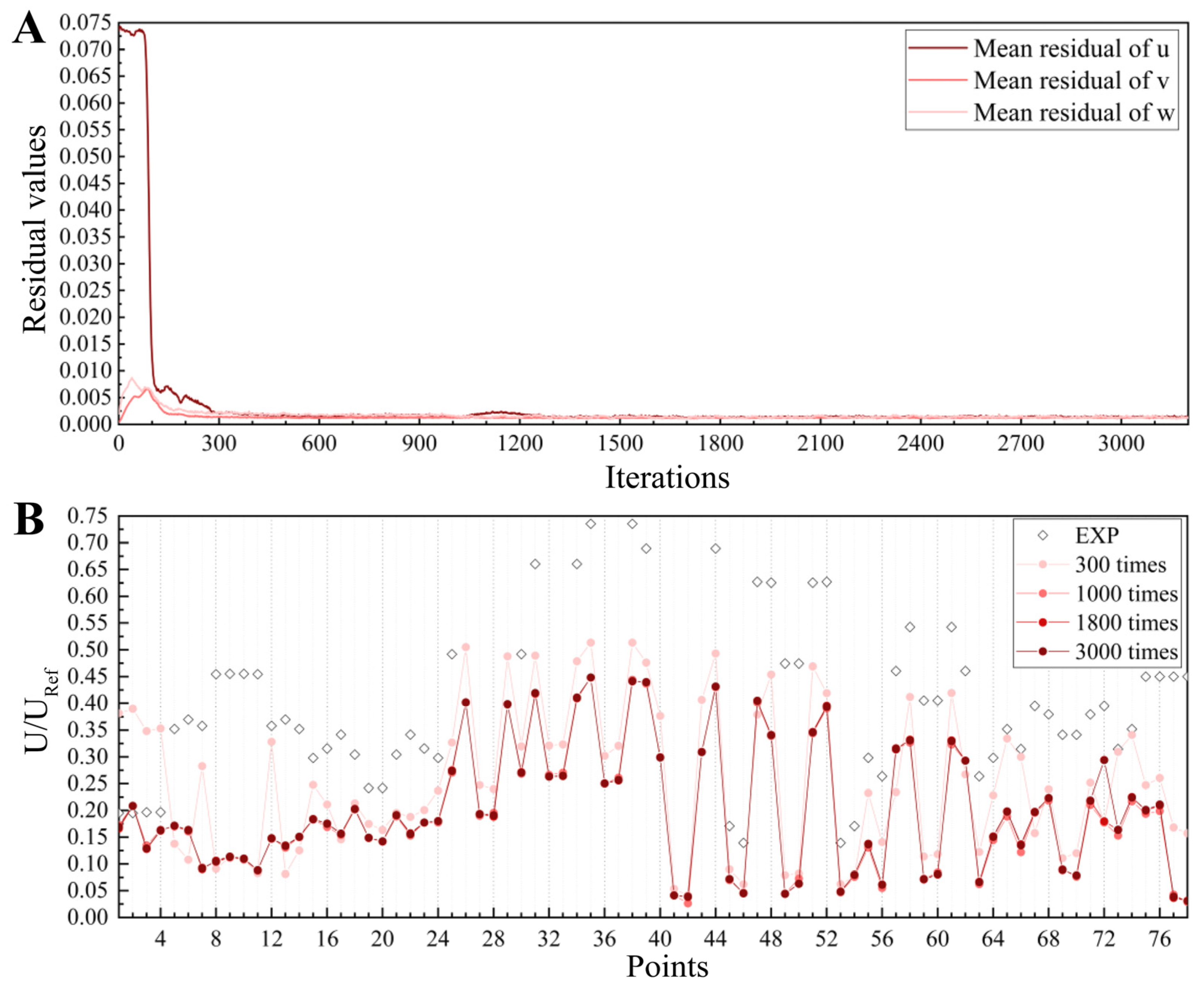


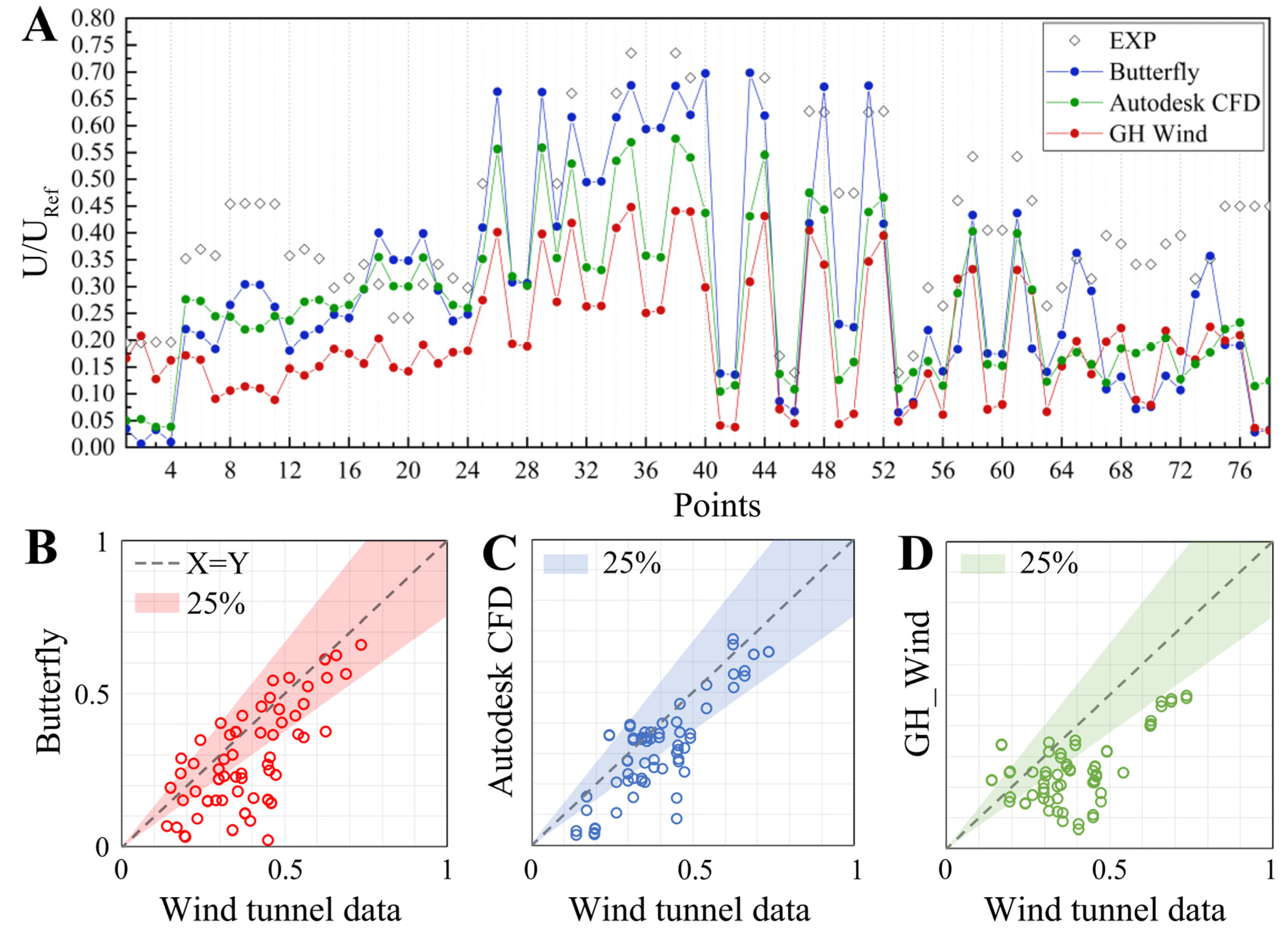

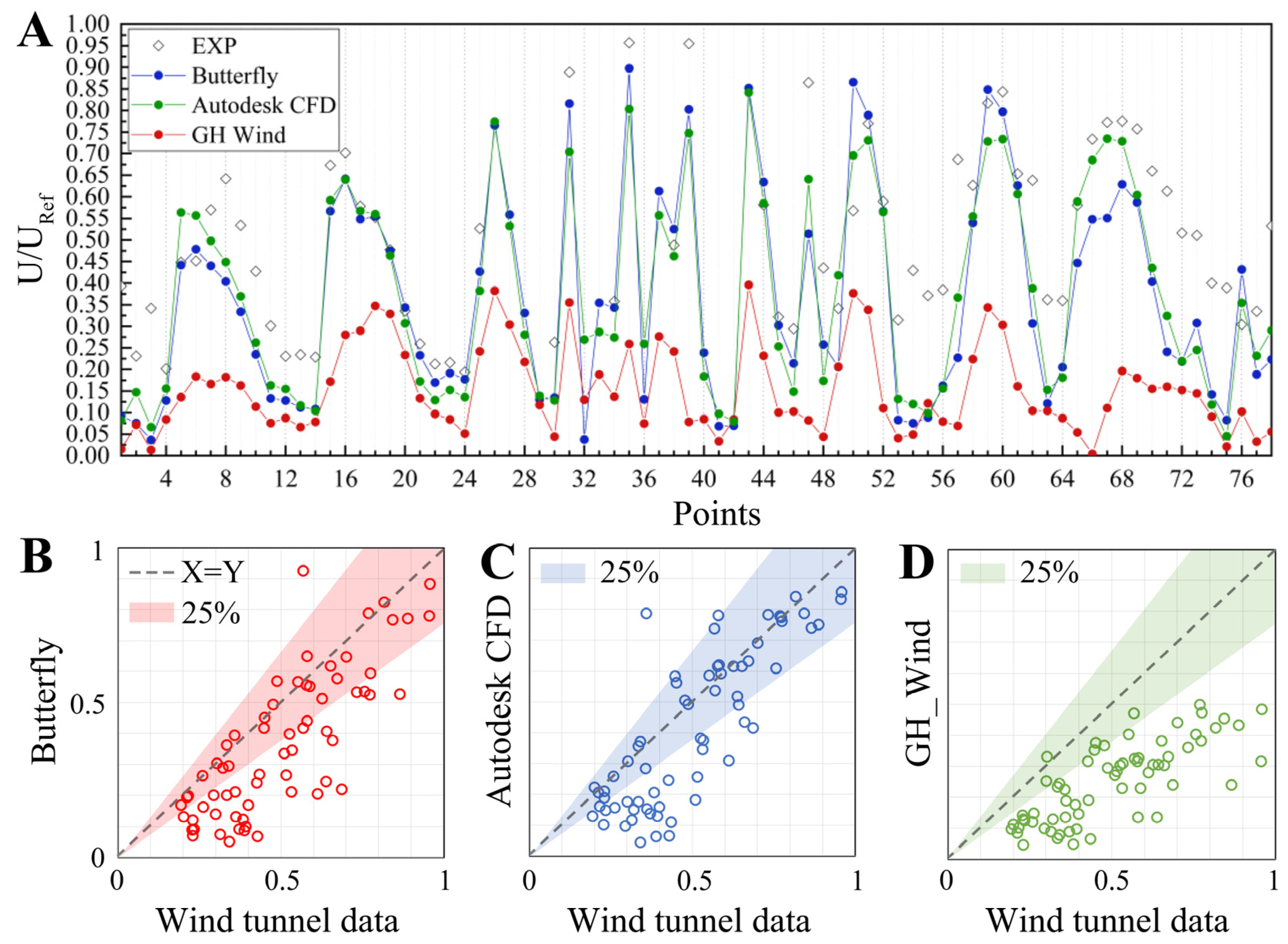
| Grid Schemes | Grid 1 | Grid 2 | Grid 3 | Grid 4 | Grid 5 | Grid 6 | Grid 7 |
|---|---|---|---|---|---|---|---|
| Minimum mesh size (m) | 2.5 | 1.875 | 1.25 | 0.83 | 0.625 | 0.5 | 0.44 |
| Number of the total meshes (million) | 0.073 | 0.13 | 0.4 | 0.86 | 1.3 | 2.8 | 8.4 |
| Iterations (times) | 5000 | 5000 | 5000 | 5000 | 5000 | 5000 | 5000 |
| Computation time (h) | 0.35 | 1.6 | 4.2 | 6.9 | 11.3 | 20.6 | 47.3 |
| Grid Schemes | Grid 1 | Grid 2 | Grid 3 | Grid 4 | Grid 5 |
|---|---|---|---|---|---|
| Number of the total meshes (million) | 0.26 | 0.58 | 1 | 1.8 | 2.6 |
| Iterations (times) | 500 | 500 | 500 | 500 | 500 |
| Computation time (h) | 0.25 | 0.5 | 1.1 | 1.5 | 3.7 |
| Grid Schemes | Grid A | Grid B | Grid C | Grid D | Grid E | Grid F |
|---|---|---|---|---|---|---|
| Global grid size (m) | 24 | 18 | 12 | 8 | 4 | 2 |
| Number of the total meshes (million) | 0.0135 | 0.03.2 | 0.108 | 0.365 | 2.915 | 23.32 |
| Iterations (times) | 1800 | 1800 | 1800 | 1800 | 1800 | 1800 |
| Computation time (h) | 0.1 | 0.18 | 0.52 | 1.56 | 13.52 | 58.3 |
| Computational Conditions | Parameter Configuration | ||
|---|---|---|---|
| Computational domain size | 1.8 m × 1.8 m × 1.8 m | ||
| Grid type | Butterfly | Structured grid | |
| GH_Wind | Structured grid (voxelization) | ||
| Autodesk CFD | Unstructured grid | ||
| Reference wind velocity | 6.65 m/s (at 10 m height) | ||
| Convection item | |||
| Boundary conditions | Inlet | Butterfly | Inflow profile in logarithmic function |
| GH_Wind | |||
| Autodesk CFD | Inflow profile in “velocity-height” piecewise linear function | ||
| Outlet | Butterfly | Pressure outlet condition | |
| Autodesk CFD | |||
| GH_Wind | Zero gradient condition | ||
| Top | No-slip wall condition | ||
| Ground | |||
| Sides | |||
| Turbulence models | Butterfly | RNG k-epsilon turbulence model | |
| Autodesk CFD | |||
| GH_Wind | |||
| CFD Plug-Ins | Simulation Accuracy | The Accuracy Trend with Increasing Angles (0°–22.5°–45°) | ||||
|---|---|---|---|---|---|---|
| Overall | Around the Central Building | |||||
| Windward | Leeward | Left | Right | |||
| Butterfly | ★★ | ★★ | ★ | ★★ | ★★ | ↓ and then ↑ |
| Autodesk CFD | ★ | ★★ | ★★ | ★ | ★ | ↑ |
| GH_Wind | ★ | ★ | ↓ | |||
| Architectural Design Platforms | CFD Plug-Ins | Simulation Categories | GUIs (or Not) | Simulation Capabilities | ||||
|---|---|---|---|---|---|---|---|---|
| Airflow | Pollutant | Thermal | Accuracy | Speed | Ease of Operation | |||
| Autodesk Revit | Autodesk CFD | √ | √ | √ | √ | ★★ | ★ | ★ |
| Rhino Grasshopper | Butterfly | √ | ★ | |||||
| GH_Wind | √ | ★★ | ★★ | |||||
Publisher’s Note: MDPI stays neutral with regard to jurisdictional claims in published maps and institutional affiliations. |
© 2022 by the authors. Licensee MDPI, Basel, Switzerland. This article is an open access article distributed under the terms and conditions of the Creative Commons Attribution (CC BY) license (https://creativecommons.org/licenses/by/4.0/).
Share and Cite
Hu, Y.; Xu, F.; Gao, Z. A Comparative Study of the Simulation Accuracy and Efficiency for the Urban Wind Environment Based on CFD Plug-Ins Integrated into Architectural Design Platforms. Buildings 2022, 12, 1487. https://doi.org/10.3390/buildings12091487
Hu Y, Xu F, Gao Z. A Comparative Study of the Simulation Accuracy and Efficiency for the Urban Wind Environment Based on CFD Plug-Ins Integrated into Architectural Design Platforms. Buildings. 2022; 12(9):1487. https://doi.org/10.3390/buildings12091487
Chicago/Turabian StyleHu, Yongyu, Fusuo Xu, and Zhi Gao. 2022. "A Comparative Study of the Simulation Accuracy and Efficiency for the Urban Wind Environment Based on CFD Plug-Ins Integrated into Architectural Design Platforms" Buildings 12, no. 9: 1487. https://doi.org/10.3390/buildings12091487
APA StyleHu, Y., Xu, F., & Gao, Z. (2022). A Comparative Study of the Simulation Accuracy and Efficiency for the Urban Wind Environment Based on CFD Plug-Ins Integrated into Architectural Design Platforms. Buildings, 12(9), 1487. https://doi.org/10.3390/buildings12091487








